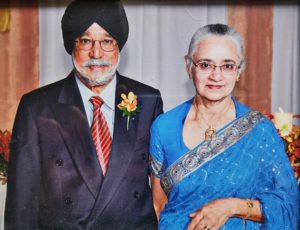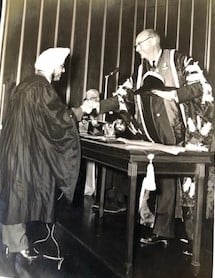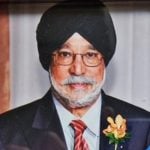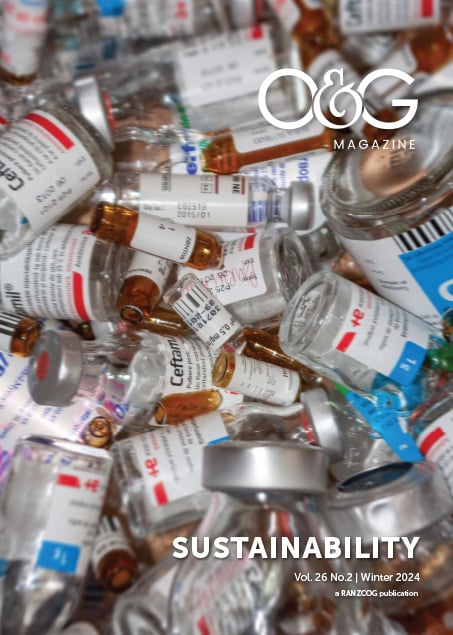Australia welcomed my family and I with open arms in 1976, and this endowment is one way my wife and I would like to return the gesture with gratitude.
– Dr Mukhtiar Sidhu
Earlier this year, the College received a generous bequest from retired fellow Dr Mukhtiar Sidhu and Mrs Raghbir Kaur Sidhu and the Sidhu family. Thanks to this bequest, the College will support and deliver The Mukhtiar and Raghbir Sidhu RANZCOG Asian and Pacific Developing Countries Education Grant. Here, Dr Mukhtiar Singh Sidhu shares some memorable moments from his lifetime commitment to O&G work and what he and his family hope the Grant will achieve.
Tell us a bit about your family & background
I was born in a small village in the state of Punjab, India, in 1937. My father had emigrated to Singapore, where he was working on the British Naval Base in Sembawang, in the north of the island state. My mother and I joined him by boat in 1941, shortly before the fall of Singapore to the Japanese. So, I spent some of my early years living under Japanese occupation, then started school at the age of nine once the region returned to British governance. We were part of a close-knit Indian Sikh diaspora that provided personnel on the Naval Base including guards, police officers and dock workers (my father was a crane driver at the Naval Base). I grew up in Singapore, attending school and then university there, which was achieved through a combination of good academic results, effort, and various bursaries and scholarships.
Why did you choose to pursue a career in O&G?
I graduated from university in late 1962, and at the time there were two main public hospitals in Singapore: a general and maternity hospital, Kendang Kerbau. I spent my first six months as a graduate “houseman” at the general hospital, and my second six months at Kendang Kerbau (KK) Hospital, and there I remained! At first, this was primarily driven by doctor shortages and where I was needed most but I enjoyed the specialisation and decided to pursue it.
What were the early days of your career like?
My experience at the KK hospital in the early days of my career stands out the most. In around 1963, this hospital had around 44,000 deliveries in one year (which equates to an average of 120 births a day) and I was one of a small handful of trainee doctors working with other staff to achieve this. As trainees, we covered all routine and complex situations including caesarean sections, forceps and breech deliveries alongside a range of gynaecological procedures. It was an incredibly high pressure, high workload, and high-time commitment period in my career. I believe that the statistic of 44,000 deliveries was noted in the Guinness Book of Records. It was a quality training environment though; when the UK College of Obstetrics and Gynaecology visited around that time to audit the hospital, it was impressed with the standards and the low maternal and neonatal morbidity and mortality rates, and approved the hospital to provide 18 months out of the then two-year specialist training period (with the remaining six months and final examinations conducted in the UK).

Dr Mukhtiar Sidhu and Mrs Raghbir Kaur Sidhu. Photo: Supplied Dr Mukhtiar Sidhu
You gained your degree in the UK, what made you decide to settle in Australia?
I was fortunate that the Singapore government was offered scholarships for specialist training in the UK as part of the Colombo Plan. So, in 1967 I was able to complete my specialist training and exams in the UK, working at St Bartholomew’s (England’s oldest hospital) and Hammersmith. At 2,000 deliveries a year, the pace at St Bart’s was somewhat more manageable and I found that I was relatively experienced given the range of cases I had been trained to handle at the KK Hospital. After that, I returned to Singapore and continued to work in the public hospital system, eventually becoming a consultant and deputy head of a unit.
By the mid-1970s, my wife Raghbir and I were very comfortably settled in our respective professional lives (she was a teacher), but we felt that a more balanced and equitable education system would benefit our three young children. Although familiar with the UK, we had friends who had migrated to Australia and recommended it to us, and it felt like it would have more familiar and tolerable weather to boot. After investigation we made the call, and I accepted a position as Director of OBGYN at the Townsville General Hospital in 1976. In the process I believe I became the first doctor with an MBBS from Singapore to be accepted for registration in Queensland.
Any stand-out memories from your O&G career?
I have already mentioned my trainee time at KK Hospital and will add that by the time of my final specialist exams I had already performed 670 C-sections. One specific case that stands out is a C-section I conducted in 1974. I discovered a full abdominal pregnancy that had successfully gone to full term – both mother and baby survived.
I was pleased to have established, with fellow OBGYN Dr Noel Cassells, a purpose-built medical specialist centre in Townsville in the early 1980s. This centre ultimately housed an ophthalmologist, psychiatrist, neonatal paediatrician, gastroenterologist, and Dr Cassells and I as OBGYNs. It was fulfilling to be part of a multi-disciplinary centre, as we could discuss between us, as relevant, the needs of our patients and their children, and refer patients to each other.
I primarily practiced in a private practice in Townsville from 1977-1990 and in 1991 moved to Brisbane. There, I was Director of OBGYN at QEII and Logan hospitals in a time of expansion of OB and GYN departments and community needs on the Brisbane southside. As both the QEII GYN and Logan hospital OBGYN departments grew exponentially, I took up the position of Director of GYN at QEII from 1996 to my retirement in 2012 at the age of 75. I relished the combination of clinical gynaecological work alongside evolving the administrative and operational functioning of the department. It was fulfilling to achieve progress such as establishing a uro–gynaecological subspecialist practice, and specialised laparoscopy and colposcopy clinics alongside our general clinics. I would like to acknowledge the contribution of all my staff and colleagues from this time, in particular Dr Michael Beckmann and Dr David Salter.

Dr Mukhtiar Sidhu’s graduation ceremony at the Royal College of O&G in 1968, London, UK. Photo supplied by Dr Mukhtiar Sidhu
Tell us a bit about the Grant
The objective of the Grant is to fund activities aimed at improving maternal mortality or morbidity and assisting in fetal surveillance in developing Pacific and Asian countries. The Grant can be used to support current OBGYN trainees from these regions to participate in a 1–4-week clinical observership in any tertiary OBGYN department in Australia or New Zealand. This opportunity will allow participants to gain clinical knowledge which can be applied in their practice settings.
The Grant can also be used to support the provision of workshops and educational programs for midwives, doctors, and specialists in obstetrics or related fields in developing Pacific and Asian countries. The Fetal Surveillance Education Program (FSEP) can use the funding to deliver courses regularly in areas of need. Over time, it is hoped that we will see an improvement in maternal mortality and morbidity as a direct result of these educational courses being made available.
What inspired you to create the Grant and what are your main hopes for it?
My wife Raghbir and my intentions are two-fold. One, to make a contribution that pays forward after what has been a wonderful professional and personal life in Australia, and secondly, to harness the power of education. Education has been a very empowering factor in both of our lives and in our extended families and communities. Supporting the good work of the College was our way of paying forward within our adopted country. After discussion with the College, we felt that there was scope to support its efforts regionally to improve mother and child morbidity, and mortality through education.
We intend that the grant is perpetual, so it covers the breadth of countries across the South and Southeast Asian and Pacific region, evolving as different needs present themselves. Ultimately, we hope that the grant supports a positive legacy and contribution to enhancing women’s and infants’ health.
Find out more about The Mukhtiar and Raghbir Sidhu RANZCOG Asian and Pacific Developing Countries Education Grant.






I have personally known Dr. Mukhtiar Singh Sidhu from his KK hospital Singapore days. He was a man of few words but an extremely competent consultant. It was indeed our loss when he went off to Townsville . I am glad he has achieved much in life and done service to the Australian Collegeof O&G. My best wishes go to him and his family.